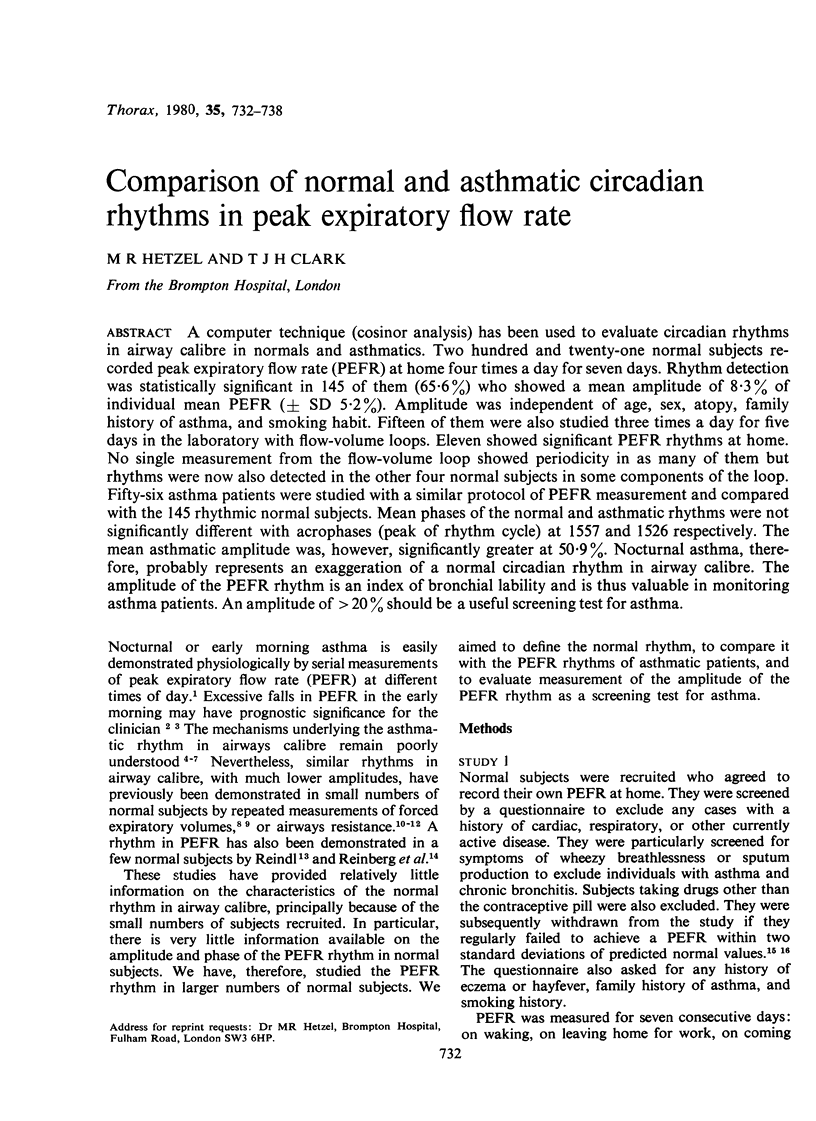Abstract
A computer technique (cosinor analysis) has been used to evaluate circadian rhythms in airway calibre in normals and asthmatics. Two hundred and twenty-one normal subjects recorded peak expiratory flow rate (PEFR) at home four times a day for seven days. Rhythm detection was statistically significant in 145 of them (65.6%) who showed a mean amplitude of 8.3% of individual mean PEFR (+/- SD 5.2%). Amplitude was independent of age, sex, atopy, family history of asthma, and smoking habit. Fifteen of them were also studied three times a day for five days in the laboratory with flow-volume loops. Eleven showed significant PEFR rhythms at home. No single measurement from the flow-volume loop showed periodicity in as many of them but rhythms were now also detected in the other four normal subjects in some components of the loop. Fifty-six asthma patients were studied with a similar protocol of PEFR measurement and compared with the 145 rhythmic normal subjects. Mean phases of the normal and asthmatic rhythms were not significantly different with acrophases (peak of rhythm cycle) at 1557 and 1526 respectively. The mean asthmatic amplitude was, however, significantly greater at 50.9%. Nocturnal asthma, therefore, probably represents an exaggeration of a normal circadian rhythm in airway calibre. The amplitude of the PEFR rhythm is an index of bronchial lability and is thus valuable in monitoring asthma patients. An amplitude of greater than 20% should be a useful screening test for asthma.
Full text
PDF






Selected References
These references are in PubMed. This may not be the complete list of references from this article.
- Bass H. The flow volume loop: normal standards and abnormalities in chronic obstructive pulmonary disease. Chest. 1973 Feb;63(2):171–176. doi: 10.1378/chest.63.2.171. [DOI] [PubMed] [Google Scholar]
- Bateman J. R., Clarke S. W. Sudden death in asthma. Thorax. 1979 Feb;34(1):40–44. doi: 10.1136/thx.34.1.40. [DOI] [PMC free article] [PubMed] [Google Scholar]
- Godfrey S., Kamburoff P. L., Nairn J. R. Spirometry, lung volumes and airway resistance in normal children aged 5 to 18 years. Br J Dis Chest. 1970 Jan;64(1):15–24. doi: 10.1016/s0007-0971(70)80045-6. [DOI] [PubMed] [Google Scholar]
- Guberan E., Williams M. K., Walford J., Smith M. M. Circadian variation of F.E.V. in shift workers. Br J Ind Med. 1969 Apr;26(2):121–125. doi: 10.1136/oem.26.2.121. [DOI] [PMC free article] [PubMed] [Google Scholar]
- HALBERG F., DIFFLEY M., STEIN M., PANOFSKY H., ADKINS G. COMPUTER TECHNIQUES IN THE STUDY OF BIOLOGIC RHYTHMS. Ann N Y Acad Sci. 1964 Jul 31;115:695–720. [PubMed] [Google Scholar]
- Hetzel M. R., Clark T. J., Branthwaite M. A. Asthma: analysis of sudden deaths and ventilatory arrests in hospital. Br Med J. 1977 Mar 26;1(6064):808–811. doi: 10.1136/bmj.1.6064.808. [DOI] [PMC free article] [PubMed] [Google Scholar]
- Hetzel M. R., Clark T. J. Does sleep cause nocturnal asthma? Thorax. 1979 Dec;34(6):749–754. doi: 10.1136/thx.34.6.749. [DOI] [PMC free article] [PubMed] [Google Scholar]
- Hetzel M. R., Williams I. P., Shakespeare R. M. Can patients keep their own peak-flow records reliably? Lancet. 1979 Mar 17;1(8116):597–599. doi: 10.1016/s0140-6736(79)91019-5. [DOI] [PubMed] [Google Scholar]
- Kerr H. D. Diurnal variation of respiratory function independent of air quality: experience with an environmentally controlled exposure chamber for human subjects. Arch Environ Health. 1973 Mar;26(3):144–152. doi: 10.1080/00039896.1973.10666242. [DOI] [PubMed] [Google Scholar]
- LEWINSOHN H. C., CAPEL L. H., SMART J. Changes in forced expiratory volumes throughout the day. Br Med J. 1960 Feb 13;1(5171):462–464. doi: 10.1136/bmj.1.5171.462. [DOI] [PMC free article] [PubMed] [Google Scholar]
- McKERROW C. B., McDERMOTT M., GILSON J. C., SCHILLING R. S. Respiratory function during the day in cotton workers: a study in byssinosis. Br J Ind Med. 1958 Apr;15(2):75–83. doi: 10.1136/oem.15.2.75. [DOI] [PMC free article] [PubMed] [Google Scholar]
- Mills J. N. Human circadian rhythms. Physiol Rev. 1966 Jan;46(1):128–171. doi: 10.1152/physrev.1966.46.1.128. [DOI] [PubMed] [Google Scholar]
- Perks W. H., Tams I. P., Thompson D. A., Prowse K. An evaluation of the mini-Wright peak flow meter. Thorax. 1979 Feb;34(1):79–81. doi: 10.1136/thx.34.1.79. [DOI] [PMC free article] [PubMed] [Google Scholar]
- Reinberg A., Gervais P. Circadian rhythms in respiratory functions, with special reference to human chronophysiology and chronopharmacology. Bull Physiopathol Respir (Nancy) 1972 May-Jun;8(3):663–677. [PubMed] [Google Scholar]
- Reindl K., Falliers C., Halberg F., Chai H., Hillman D., Nelson W. Circadian acrophase in peak expiratory flow rate and urinary electrolyte excretion of asthmatic children: phase shifting of rhythms by prednisone given in different circadian system phases. Rass Neurol Veg. 1969;23(1):5–26. [PubMed] [Google Scholar]
- Soutar C. A., Carruthers M., Pickering C. A. Nocturnal asthma and urinary adrenaline and noradrenaline excretion. Thorax. 1977 Dec;32(6):677–683. doi: 10.1136/thx.32.6.677. [DOI] [PMC free article] [PubMed] [Google Scholar]
- Soutar C. A., Costello J., Ijaduola O., Turner-Warwick M. Nocturnal and morning asthma. Relationship to plasma corticosteroids and response to cortisol infusion. Thorax. 1975 Aug;30(4):436–440. doi: 10.1136/thx.30.4.436. [DOI] [PMC free article] [PubMed] [Google Scholar]
- Turner-Warwick M. On observing patterns of airflow obstruction in chronic asthma. Br J Dis Chest. 1977 Apr;71(2):73–86. doi: 10.1016/0007-0971(77)90086-9. [DOI] [PubMed] [Google Scholar]
- Wright B. M. A miniature Wright peak-flow meter. Br Med J. 1978 Dec 9;2(6152):1627–1628. doi: 10.1136/bmj.2.6152.1627. [DOI] [PMC free article] [PubMed] [Google Scholar]


